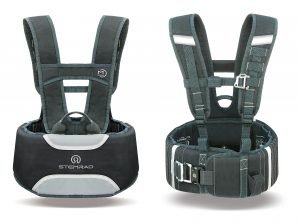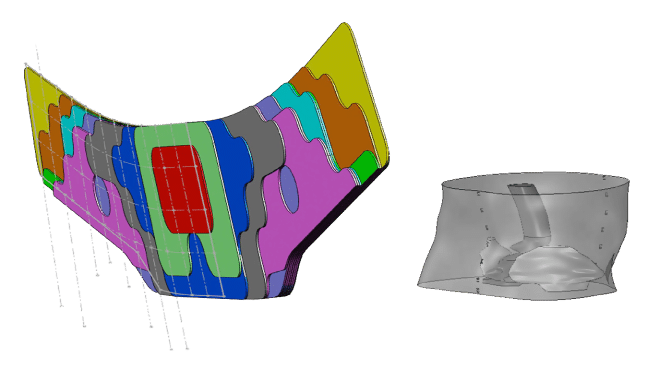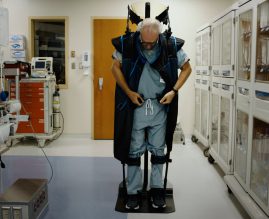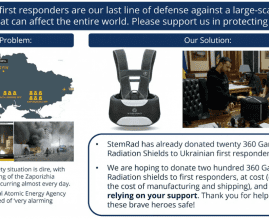What Makes for an Effective CBRN Radiation Shield?
10.31.18 | Wednesday | Nofit Amir
Professionals who deal with the aftermath of a nuclear or radiological event need personal protection. Any CBRN radiation protection solution can – or should be able to – shield workers from the devastating effects of gamma radiation. But, like with so many other things, how you approach protection is key. Many of the radiation protection devices touted for protection are inefficient, heavy – and ineffective in blocking radiation associated with nuclear or radiation incidents, as they do not provide adequate protection to the most vulnerable parts of the body. With our solution – the 360 Gamma radiation shield – personnel are equipped with smart shielding that provides focused protection from gamma radiation for the body’s most sensitive parts.
The problem with CBRN radiation shielding solutions
There are numerous approaches to gamma radiation protection, most of them based on spreading as thick a layer as possible of materials like composite metals, lead, or specialty fabrics over the body. To block typical gamma rays completely, according to the American Nuclear Society, shield thickness needs to be about 13.8 feet of water, 6.6 feet of concrete, or about 1.3 feet of lead. Thick, dense shielding is necessary to protect against gamma rays.
To protect the body against gamma rays, many of the CBRN radiation shield solutions on the market pack on the protection – to the extent that even moving in the outfits is difficult, if not impossible. At Chernobyl, for example, some of the responders tried to protect their entire bodies with thin sheets of lead similar to what is worn in hospitals to protect against low-energy X-rays (and insufficient for high-energy gamma rays). But even with 26 kilos of this material on their bodies – heavily encumbering them – their most sensitive and vulnerable body parts remained inadequately protected, and many of them died from the hematopoietic sub-syndrome of acute radiation syndrome which arises from the destruction of the bone marrow tissue.
Advanced materials for CBRN radiation shielding, not a solution either
Even when materials that are falsely touted as being more effective than lead are used, lugging around heavy whole-body protective suits considerably slows down the wearer and creates unnecessary heat stress. The average male human body has a surface area of 19,000 cm2 and the torso is approximately 36% of that surface area, which means a vest made out of material that has a density of 3.14 g/cm3 with an attenuation factor of 2 would weigh 58 kg. This is an unrealistic weight for someone to carry – and as the products on the market that use these materials are considerably lighter (that is among their selling points), they provide much less protection than would be required.
Even if you were to provide someone with a 58 kg vest providing two fold protection and they were able to wear it, the dose received is proportional to the time of exposure and by carrying an additional 58 kg one would be slowed considerably, thereby negating the benefits of the shielding or even being counter-productive and increasing the absorbed dose.
Why StemRad’s CBRN radiation shielding solution is better
Since heavy protective outfits cannot provide adequate protection while allowing freedom of movement for those wearing them, StemRad solves the problem with its innovative selective approach. StemRad’s 360 Gamma provides significant shielding arranged in the most efficient configuration to provide focused protection to the most sensitive area in the body- the pelvis, where we have 50% of the body’s bone marrow and additional sensitive tissues.
This offers efficient protection against high energy gamma radiation, which military personnel and first responders would encounter during a nuclear or radiological event.
The need for robust bone marrow tissue protection is easily understood by looking at the numbers. Nuclear first responders are not working with X-ray machines, which emit radiation at low energies (about ten times lower), but with high energy gamma emitters like Cs-137 (662 keV). As the energy of radiation increases, so does its ability to penetrate through shielding – thus there is a need for thicker shielding at critical areas.
But as we have seen, thick shielding throughout is impractical – and often ineffective. The StemRad approach of selectively shielding critical bone marrow tissue with robust shielding is the best way to protect humans from gamma radiation. When detection systems indicate they are required, the best approach is a CBRN gamma radiation shield – a modular add-on to standard thin HAZMAT suits, blocking externally-penetrating radiation. This efficient approach allows first responders to operate efficiently without undue weight burden with a solutio fully compatible with their existing PPE. The StemRad 360 Gamma offers the greatest biological protection without compromising mobility by providing significant, focused, selective shielding where it matters most.
Frequently Asked Questions
What does CBRN stand for?
CBRN is an acronym for chemical, biological, radiological, or nuclear hazards.
What is an example of a CBRN threat?
One example of a CBRN threat is a radiological disaster, which could be caused by a "dirty" bomb dispersing radioactive material. Another example is a nuclear detonation, which could generate harmful radiation to the surrounding population and first responders .
How does CBRN impact the body?
Chemical, biological, and radiological contaminants can be ingested or inhaled, while nuclear hazards can cause damage via radiation exposure without any contact necessary.
What is the difference between HAZMAT and CBRN?
CBRN events differ from hazmat incidents in both scope and intent. CBRN events can be mass-casualty situations and are generally considered to be intentional and malicious.

Writes content for StemRad’s website, social media, and newsletter. She is an advocate with over twenty years of experience of writing high-end content in academic and industrial settings.




